Question (WOODWEB Member) :
I posted a thread a while back about wingback chairs and I learned a lot about what not to do, and what works in a new world for me and my business. Included was my choice of wood as well as my methods of construction. They were all influenced by books and folks opinionís here at WOODWEB, so thank you for all of your help. I ended up using alder as my choice of wood for the chairs and after doing this as my first project in furniture I learned a lot. I made templates of everything and produced pre-made pieces. I altered the back on one and left the wings off, and I rounded the corners slightly as an experiment and it looked great (these are at the request of a designer I build for, he foots the bill while I experiment).
The designer had a pair of club chairs in his living room and being a designer, he has some ideas about what he wants me to build for his furniture line and I am a complete novice (I do cabinets, finish carpentry, but am just getting into the furniture thing). The chair is deep, 30" or so, and he wants a couch 90" wide of the same type. I was at a loss, so I told him I would have to tear the new upholstery off of one of the chairs to see how it was built. I had books, but to be perfect and exact I needed the actual chair frame. He said no problem Ė he has the money. I tore off the fabric and I am horrified at the craftsmanship that passes for fine furniture these days.
The cuts were off by ten degrees or more, and it was all stapled together. There was one gap of over 3/8" that was just left there. It was somewhat stable, but dang, what a shame. I made mine in the same type, but used tight joints, lots of glue, and here's the thing I know many will cringe at - I used screws in the entire project, namely pocket screws. I used 5/4 material, screwed with a Kreg jig and cabinet screws, and used Titebond II - not a single dowel, tenon or biscuit.
Trying to make a decent product in comparison to what I was copying was easy but I went a step farther and made a very high quality product. How many people think the pocket screws and glue will hold for 20 plus years, and how many think it will fail? I am curious. If the original chair lasted this long, I believe I have a quality product.
Opinions are welcome! Am I over building or underbuilding? My experience with glue and screws is very positive so far. (NOTE: The picture is not finished. It still gets complete 5/4 by 3" frame around the bottom, corner blocks, and a 5" board across the front footrest area for support. Itís beefy already, and it will survive a tornado after I am done).
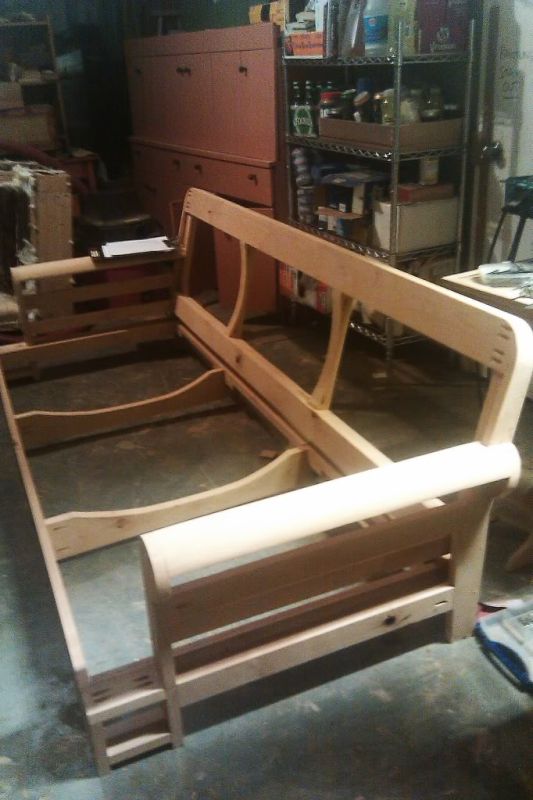
Forum Responses
(Furniture Making Forum)
From contributor K:
What you have built using pocket screws is a piece of furniture with butt joints. Screws (even pocket screws) are just a clamping mechanism to hold a joint until the glue dries. Your joints that are end to edge grain will not hold up over time. Pocket screws and glue hold up well in a static situation such as a cabinet face frame, but are not good for furniture where there is movement and stress placed on every joint. You should consider using mortise and tenon construction. Your club couch will be fine if no one ever sits on it.
There are a few dowels and interlocking pieces, but really, how many people have built an entire couch with mortise and tenon joints unless it is going to be exposed? You would have to charge $3000 just for the frame. Contributor D has it right; even if I removed the screws I would guarantee it for a long time. Glue today is exceptional, and I have glued up joints many times and tried to break them; the wood always fails before the glue. It may seem pocket screws are too small or won't hold, I'll let you know in 20 years! I can't even get a squeak when I twist it and lift it. In fact, with all the couches I have sat on it feels the beefiest even before corner blocks (20 of them).
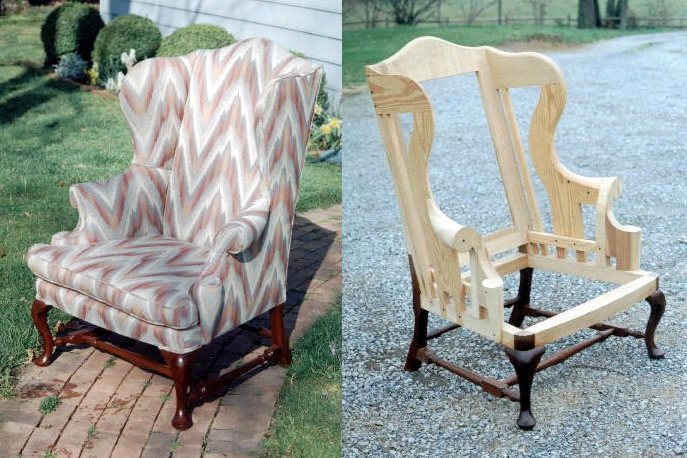
How did the chair I am reproducing from survive a couple of decades with staples and nothing else? The amount of pieces is why - there are a lot of parts and corner blocks. I would feel free to let any person sit on my couch when finished and be confident in its construction.
It's like this - if a few staples and 1/4" gaps held up on the original, and well, my piece with glue, screws, and blocks will hold up to anything a family can throw at it. I may eat my words in 20 years, but I highly doubt it. Have you taken apart a standard couch and seen the inside? It is junk. Besides fine furniture, like the picture above of the chairs, screws have come a long way.
I have built dozens of different types of things, panels, murals, mantles, and I have a pretty good idea of what works. While I know furniture is completely different, a couch is going to spend a lot of time getting used, if my crappy couch at home can survive years of dogs and kids my new one will do ten times better. I guarantee the springs will go out long before it squeaks! If anyone has ever used this method of screws and pocket screws I would love to hear from your experiences. Modern fasteners have come a long way.
Unless you have built a couch this way before and had a callback, there is really no way to prove it one way or another. Like I said before; if staples work then screws can only be an improvement. If it was a $25,000 couch I would tenon everything but that's just not the case. Even if I did I doubt it would make that much of a difference. I finished it now and it's one beefy beast. Heavy and ready for upholstery!
I use dowels anywhere I can as long as I am not compromising the integrity of the piece. I also like to use #12 2" screws in areas that are too fragile or awkward to dowel or tenon. While many of the above points from folks are totally valid, I still see no reason why not to use screws and dowels where able. I guess when we get used to doing something a certain way we often fail to be objective toward other possible methods. Many times for good reason, many times just because it is out of our comfort zone. "Why take the risk" becomes a phrase we use on big projects, and seldom do we have the chance to take a different approach and see what happens. It is too costly to make a mistake.
I am in a good place for that. I will take everything I have learned here on the forum and in books and combine them to make a method that is solid and durable. I recently made my first chair from scratch, with no plans, and no idea what it may look like in the end. My only thing was it had to have no fasteners other than wood - I used mostly dowels, with the base mortised with floating tenons. So I do know how to do these things I just like to experiment with other joinery methods. The picture below is a photo of the armrest joined to the back - pretty darn solid!
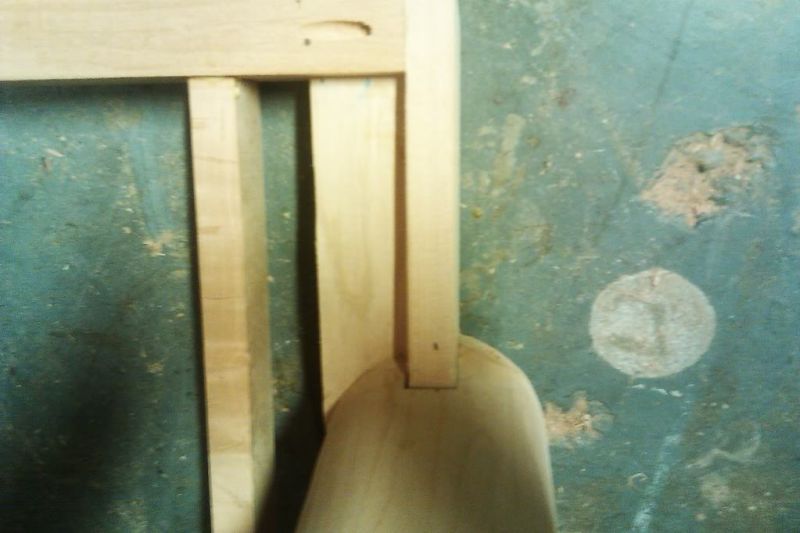
I can, however, offer some small bits of info to help in your project. Screw failure is generally caused by either carelessness in installation or corrosion. Impact drivers and proper selection help with the first, and for the latter stainless steel fasteners last forever. The other thing to keep in mind when factoring into your engineering all of the improvements in materials that have occurred over the years is that the dominant material that you're working in has effectively degraded in as much time.
On another note, it may be helpful in the future, perhaps even with your existing client to be a bit more realistic about the longevity of the pieces. Or, stated another way; the useful life of anything is an important design criteria. I imagine that you want to continue your education in this field, so be careful about overselling your current endeavors. In the company of the above posts, this may sound like I'm giving you a hard time, but really, I'm not. I think that you've done a good job making a middle of the road frame.
It is going to be more of a show piece than for sale. The designer wants me to make a few chairs, and a sofa and couch, plus a couple of end tables and coffee table. Then he will take pictures, and start his furniture line. If it takes off, it will be great. I have to be cost effective until he actually sells something. Right now he is investing his own money, so I am in a tight spot.
I do use stainless fasteners, and try to get the cleanest 5/4 and 8/4 hemlock for my body. It is important to make a quality product, as I am a nitpicker about detail. Now finished, there are dowels, laps and screws throughout. I think it will be a good first run. I guess I have to be firm, at $300 a frame I would get eaten alive. I don't even know how to charge.
So if I am getting $1100 for each chair including material, how would I charge for a couch? I mean, it takes about the same time, and I know the money is in the upholstery. Would $1500 be too much for me to charge? I know that is really a dumb question. It depends on where you live, who you sell to, what your expenses are.
I run a tight ship. I have very little overhead, no expensive machinery, just the basics. I can't invest too much in furniture making machinery, because by trade I am a finish carpenter and if the furniture business fails, I don't want to be stuck with a huge investment in tools. Because of that, I spend a lot of time tooling up for different furniture, new templates, then next month a full kitchen of cabinets, you get the picture. I don't have a "dedicated" space for this, and I work alone. So if he is willing to give me $1500 a couch frame, it would allow me to make a much better product without feeling rushed or cheated.
I am sure he will price them at $4500 or more, so I can't feel too guilty. I like to be fair and I have no idea what the client expects as far as longevity, but if he is anything like me, hopefully a long time. I have brushed nickel plaques I place on every cabinet and furniture piece I make. I don't want someone calling me in 20 years to tell me what a crappy product I made!
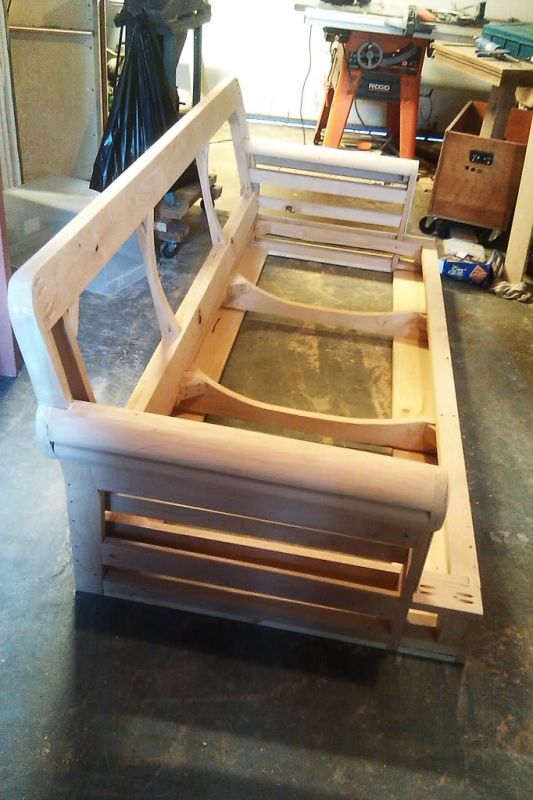
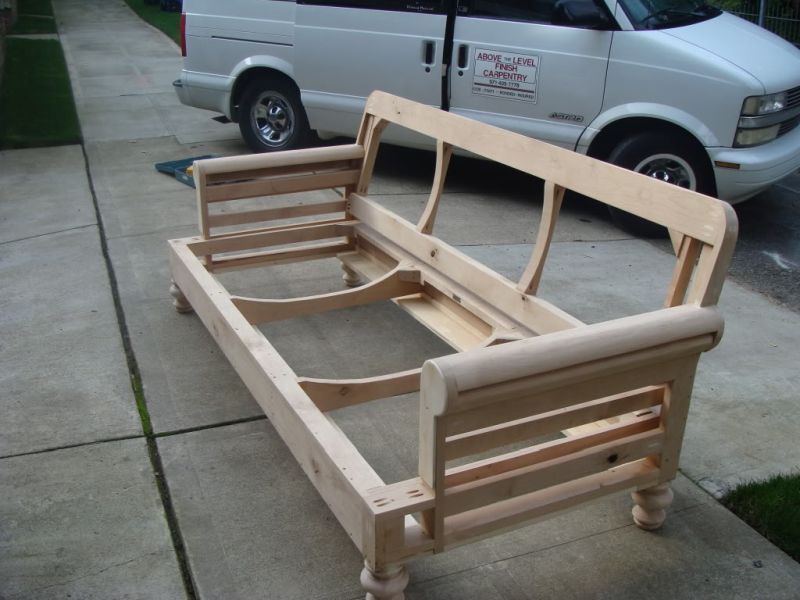
I just found out that he wants me to make another couch, same size. This time I will M&T the handrail and base. I will use floating tenons until I get a perfect frame size, then I can modify as needed. It is like stepping into a new career; I am used to building cabinets and libraries, shelving, hanging crown, mouldings, and the like. Now I have to re-tool my shop for furniture. I'll get it figured out!